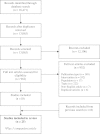A systematic review of the use and effectiveness of social media in child health
- PMID: 24886048
- PMCID: PMC4047773
- DOI: 10.1186/1471-2431-14-138
A systematic review of the use and effectiveness of social media in child health
Abstract
Background: Social media use is highly prevalent among children, youth, and their caregivers, and its use in healthcare is being explored. The objective of this study was to conduct a systematic review to determine: 1) for what purposes social media is being used in child health and its effectiveness; and 2) the attributes of social media tools that may explain how they are or are not effective.
Methods: We searched Medline, CENTRAL, ERIC, PubMed, CINAHL, Academic Search Complete, Alt Health Watch, Health Source, Communication and Mass Media Complete, Web of Knowledge, and Proquest Dissertation and Theses Database from 2000-2013. We included primary research that evaluated the use of a social media tool, and targeted children, youth, or their families or caregivers. Quality assessment was conducted on all included analytic studies using tools specific to different quantitative designs.
Results: We identified 25 studies relevant to child health. The majority targeted adolescents (64%), evaluated social media for health promotion (52%), and used discussion forums (68%). Most often, social media was included as a component of a complex intervention (64%). Due to heterogeneity in conditions, tools, and outcomes, results were not pooled across studies. Attributes of social media perceived to be effective included its use as a distraction in younger children, and its ability to facilitate communication between peers among adolescents. While most authors presented positive conclusions about the social media tool being studied (80%), there is little high quality evidence of improved outcomes to support this claim.
Conclusions: This comprehensive review demonstrates that social media is being used for a variety of conditions and purposes in child health. The findings provide a foundation from which clinicians and researchers can build in the future by identifying tools that have been developed, describing how they have been used, and isolating components that have been effective.
References
-
- Madden M, Lenhart A, Duggan M, Cortesi S, Gasser U. Teens and Technology 2013. [ http://www.pewinternet.org/Reports/2013/Teens-and-Tech.aspx]
-
- Lenhart A. Teens, Smartphones & Texting. [ http://www.pewinternet.org/Reports/2012/Teens-and-smartphones/Summary-of...]
-
- Lenhart A, Madden M, Smith A, Macgill A. Teens and Social Media, Report: Teens, Social Networking, Blogs, Videos, Mobile. [ http://www.pewinternet.org/Reports/2007/Teens-and-Social-Media.aspx]
-
- Schurgin O’Keeffe G, Clarke-Pearson K. Council on Communications and Media. The impact of social media on children, adolescents, and family. Pediatrics. 2011;127(4):4. - PubMed
Publication types
MeSH terms
Grants and funding
LinkOut - more resources
Full Text Sources
Other Literature Sources
Medical


